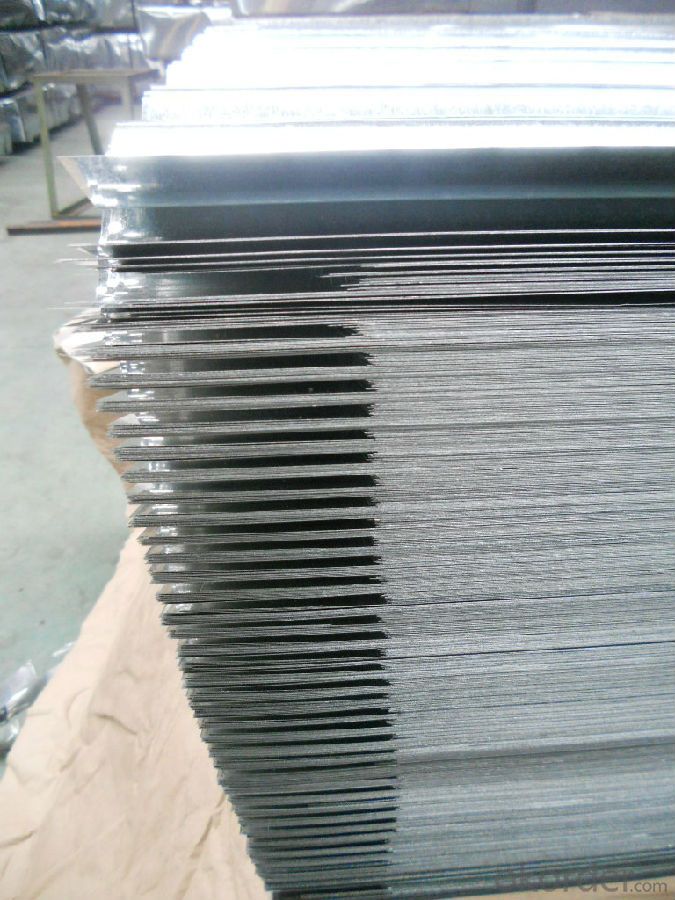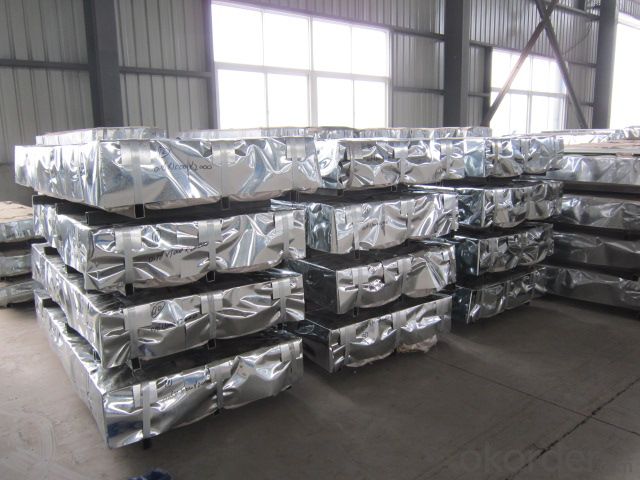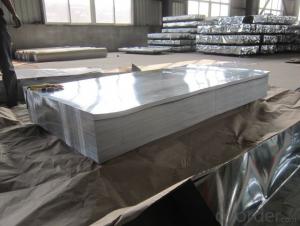Hot-dip Galvanized Steel Sheets in Sheet
- Loading Port:
- Shanghai
- Payment Terms:
- TT OR LC
- Min Order Qty:
- 25 m.t.
- Supply Capability:
- 1000 m.t./month
OKorder Service Pledge
OKorder Financial Service
You Might Also Like
Description:
The external layer is all zinc, but successive layers are a mixture of zinc and iron, with an interior of pure steel. These multiple layers are responsible for the amazing property of the metal to withstand corrosion-inducing circumstances. Zinc also protects the steel by acting as a "sacrificial layer." If rust does take hold on the surface of Galvanized Steel Coil, the zinc will get corroded first. This allows the zinc that is spread over the breach or scratch to prevent rust from reaching the steel.
Architecture Roofs and outside walls of civilian and industrial buildings, garage doors, fencings
1. Good Resistance to Corrosion
2. Qualified Processing Machinability
3. High Thermal Resistance


Application:
Construction, packaging, railway vehicles, agricultural machinery and daily life.
For countless outdoor, marine, or industrial applications, Galvanized Steel Coil is an essential fabrication component.
Architecture Roofs and outside walls of civilian and industrial buildings, garage doors, fencings and window blinds.
Appliances Industry Outer clad sheets for washing machine, refrigerator, television, air conditioner and ventilation system, explosion-proof strip, solar water heater and appliance parts.
Product Specification:
Base sheet : galvanized steel sheet, pre painted galvanized steel sheet
Zinc:40G-275G
Thickness:0.12mm-3.0mm
Width:600mm-1250mm
Length:1000mm-11800mm or as request
Package:3 layers of packing, inside is kraft paper,water plastic film is in the middle and outside GI steel sheet to be covered by steel strips with lock.
FAQ:
1.How many pieces for one ton of the Hot-dip Galvanized Steel Sheet?
The pieces for one tone is decided by the thickness of the sheet, but we can make it according to your requirements in the reasonable range.
2. Do you have pallets for the package?
Yes, we must use pallets for the package in order to load.
3. How many tons do you load in one 20’FCL?
- Q:Can steel sheets be used for fencing or security purposes?
- Yes, steel sheets can be used for fencing or security purposes. Steel sheets provide strong and durable barriers, making them suitable for fencing applications to protect properties or secure areas. Additionally, their robustness and resistance to impact make them ideal for enhancing security by preventing unauthorized access.
- Q:Are steel sheets suitable for railway track construction?
- Yes, steel sheets are suitable for railway track construction. Steel sheets are commonly used in the construction of railway tracks due to their high strength, durability, and resistance to wear and tear. They provide stability to the tracks, allowing trains to operate smoothly and efficiently. Additionally, steel sheets are capable of withstanding heavy loads and extreme weather conditions, making them an ideal choice for railway track construction.
- Q:Are steel sheets suitable for architectural roofing?
- Yes, steel sheets are suitable for architectural roofing. Steel is a highly durable and long-lasting material, making it an excellent choice for architectural roofing applications. Steel sheets offer significant strength, allowing them to withstand harsh weather conditions, including heavy rain, snow, and strong winds. They are also fire-resistant, which adds an extra layer of safety to the building. Moreover, steel sheets are lightweight compared to other roofing materials, making them easier to install and reducing the overall load on the structure. Additionally, steel sheets come in a variety of colors and finishes, allowing architects to achieve the desired aesthetic appearance for the building. Overall, steel sheets offer numerous advantages for architectural roofing, making them a suitable choice for both residential and commercial projects.
- Q:What are the weight considerations for steel sheets?
- Weight considerations for steel sheets vary depending on the specific application and desired outcomes. Here are a few important points to keep in mind: 1. Thickness: The weight of a steel sheet is greatly influenced by its thickness. Thicker sheets generally have more weight, while thinner sheets are lighter. It is important to select a thickness that meets the project's structural requirements while also considering weight limitations. 2. Strength requirements: Different applications call for steel sheets with varying levels of strength. High-strength sheets are often thicker and heavier, while lower strength sheets can be thinner and lighter. Understanding the strength requirements of the project is essential in determining the appropriate weight of the steel sheets. 3. Transportation and handling: The weight of steel sheets affects how easy they are to transport and handle. Heavier sheets require more labor and equipment for lifting, loading, and unloading. Additionally, transport vehicles have weight restrictions that must be taken into account when choosing sheet sizes. 4. Structural limitations: The weight of steel sheets can impact the overall structural design. In some cases, lighter sheets may be preferred to reduce the load on supporting structures. However, in other situations, heavier sheets may be necessary to provide the required strength and stability. 5. Cost considerations: The weight of steel sheets also affects the overall project cost. Heavier sheets generally cost more due to the increased material needed and additional handling expenses. Therefore, it is important to find a balance between weight, cost, and performance to optimize the project budget. In conclusion, weight considerations play a crucial role in determining the appropriate thickness, strength, transportation requirements, structural design, and cost-effectiveness of steel sheets for a project. By carefully evaluating these factors, one can select steel sheets that meet specific needs while ensuring the optimal weight for the desired outcome.
- Q:Are steel sheets prone to rusting?
- Yes, steel sheets are prone to rusting as they are primarily made of iron, which is highly susceptible to corrosion when exposed to moisture and oxygen. However, the use of protective coatings or galvanization can significantly reduce the risk of rusting in steel sheets.
- Q:Are steel sheets suitable for construction scaffolding?
- Yes, steel sheets are suitable for construction scaffolding. They are strong, durable, and can withstand heavy loads, making them an ideal choice for supporting workers and materials at various heights during construction activities.
- Q:How do you prevent rusting on steel sheets?
- There are several effective measures you can take to prevent rusting on steel sheets. 1. Protective Coatings: Applying a protective coating such as paint, enamel, or powder coating creates a barrier between the steel surface and the surrounding environment. These coatings act as a shield against moisture and oxygen, preventing rust formation. 2. Galvanization: Galvanizing steel sheets involves coating them with a layer of zinc. Zinc is highly resistant to corrosion and acts as a sacrificial anode, protecting the steel underneath. This process is commonly used for outdoor applications where steel is exposed to moisture and harsh weather conditions. 3. Proper Storage: Storing steel sheets in a dry and well-ventilated area is crucial to prevent rust formation. Moisture and humidity are major contributors to rust, so it is important to keep the steel sheets away from damp or wet environments. Additionally, storing the sheets off the ground on pallets or racks can help prevent contact with moisture. 4. Regular Cleaning and Maintenance: Regularly cleaning the steel sheets with mild detergent and water can help remove any dirt, debris, or corrosive substances that may lead to rusting. It is important to dry the sheets thoroughly after cleaning to prevent moisture accumulation. 5. VCI (Volatile Corrosion Inhibitor) Packaging: Using VCI packaging materials such as VCI paper or film can be effective in preventing rust on steel sheets during storage or transportation. VCI emits corrosion-inhibiting molecules that form a protective layer on the steel surface, preventing rust formation. 6. Avoiding Contact with Water: Avoid exposing steel sheets to water or other corrosive liquids for extended periods. If the sheets come into contact with water, it is essential to dry them thoroughly as soon as possible to prevent rusting. By following these preventive measures, you can significantly reduce the risk of rust formation on steel sheets and ensure their long-term durability and performance.
- Q:Are steel sheets resistant to fire?
- Yes, steel sheets are generally resistant to fire due to their high melting point and structural integrity, making them a commonly used material for fire-resistant construction.
- Q:Can steel sheets be etched or engraved?
- Yes, steel sheets can be etched or engraved using various techniques such as chemical etching, laser engraving, or mechanical engraving.
- Q:Can steel sheets be painted after installation?
- After the installation, it is possible to paint steel sheets for aesthetic improvement and protection against rust and corrosion. However, before applying paint, it is crucial to ensure that the surface is clean and devoid of any pollutants. Adequate preparation, such as cleaning and sanding, is necessary to promote adhesion and achieve a durable finish. It is advisable to use a primer specifically formulated for steel surfaces before applying the desired paint color. Moreover, selecting a high-quality paint suitable for exterior or industrial use will yield optimal results and longevity.
1. Manufacturer Overview |
|
|---|---|
| Location | |
| Year Established | |
| Annual Output Value | |
| Main Markets | |
| Company Certifications | |
2. Manufacturer Certificates |
|
|---|---|
| a) Certification Name | |
| Range | |
| Reference | |
| Validity Period | |
3. Manufacturer Capability |
|
|---|---|
| a)Trade Capacity | |
| Nearest Port | |
| Export Percentage | |
| No.of Employees in Trade Department | |
| Language Spoken: | |
| b)Factory Information | |
| Factory Size: | |
| No. of Production Lines | |
| Contract Manufacturing | |
| Product Price Range | |
Send your message to us
Hot-dip Galvanized Steel Sheets in Sheet
- Loading Port:
- Shanghai
- Payment Terms:
- TT OR LC
- Min Order Qty:
- 25 m.t.
- Supply Capability:
- 1000 m.t./month
OKorder Service Pledge
OKorder Financial Service
Similar products
New products
Hot products
Related keywords






























